








The magazine of the art-form of the photo-essay

May 2016 back issue
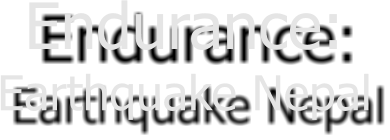


by Omar Havana
“A free, really high quality photo-essay magazine. Fabulous!”
Stephen Fry. British actor, writer and film & documentary maker
On April 25th, 2015 a 7.8 magnitude earthquake shook Nepal. Almost 9,000 people died, more than 22,000 people
suffered injuries and more than half a million houses were destroyed. For weeks aftershocks rocked the country. People
occupied the streets and open spaces in fear. Chaos dominated daily life.
One night, after running all day, photographing, as aftershocks struck repeatedly, Omar finally fell asleep, hugging his
cameras. Someone touched him. He immediately thought they might want to steal his cameras but he turned to find
instead an old woman, a woman who had lost everything, covering him with her quilt. She said, “We need to take care
of you. You are telling the world the situation in our country. At that moment, Omar began Endurance.
In order to publish Endurance Omar Havana is mounting a crowd funding campaign at Kickstarter to raise $27,000, to
make this enduring testament to strength and spirit of the people of Nepal a reality.
He welcomes direct backing for the campaign but you can also help him reach his goal by sharing the project with others
who you think might have an interest and through your social network.
Support the Kickstarter
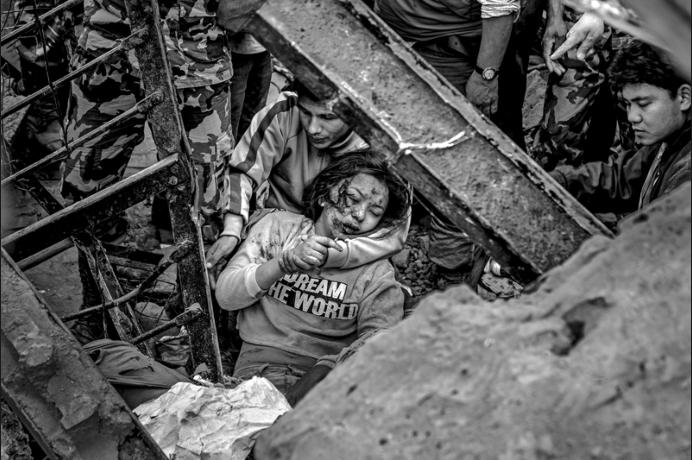
Emergency rescue workers and bystanders find a survivor in the debris of Dharara tower after it collapsed on April 25,
2015 in Kathmandu, Nepal. Minutes after the earthquake hit Nepal, teams of volunteers and response units started
working trying to find survivors covered under the debris of collapsed buildings in the historic area of Kathmandu.
Photo by Omar Havana / Getty Images.
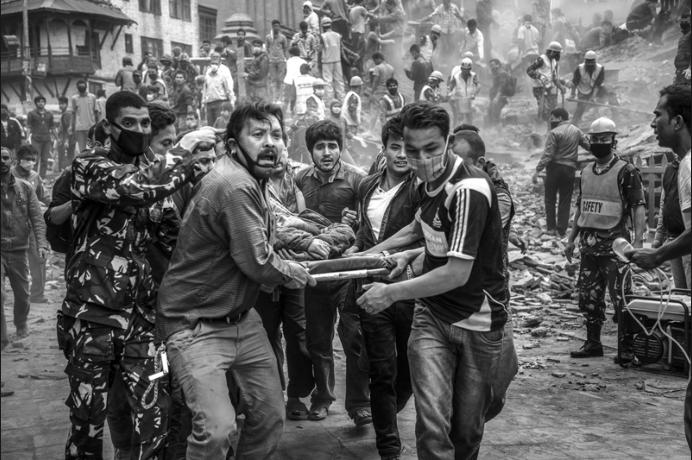
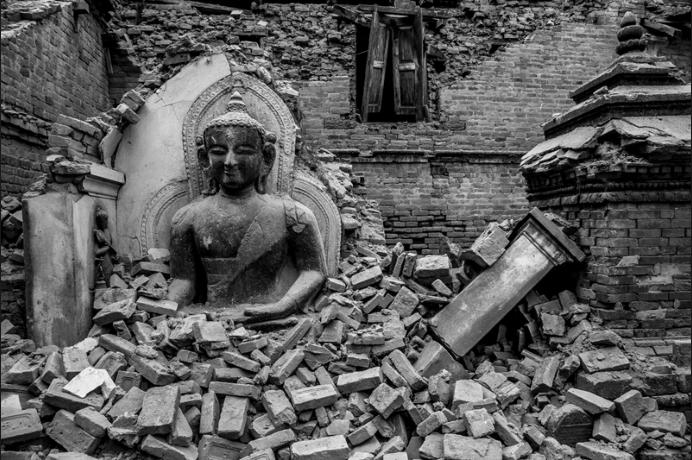
A Buddha statue is surrounded by debris from a collapsed temple in the UNESCO world heritage site of Bhaktapur on
April 26, 2015 in Bhaktapur, Nepal. Historic sites in Nepal have been heavily affected, and, according to UNESCO, it is
estimated that it could take up to ten years to rebuild most of the UNESCO World Heritage Sites in Nepal.
Photo by Omar Havana / Getty Images.
Emergency rescue workers and volunteers carry a victim on a stretcher after temples in Basantapur Durbar Square
collapsed on April 25, 2015 in Kathmandu, Nepal. A major 7.8 earthquake hit Kathmandu mid-day on Saturday, and
was followed by multiple aftershocks that triggered avalanches on Mt. Everest that buried mountain climbers in their
base camps. Many houses, buildings and temples in the capital were destroyed during the earthquake, leaving
thousands dead or trapped under the debris as emergency rescue workers attempted to clear debris and find survivors.
Photo by Omar Havana / Getty Images
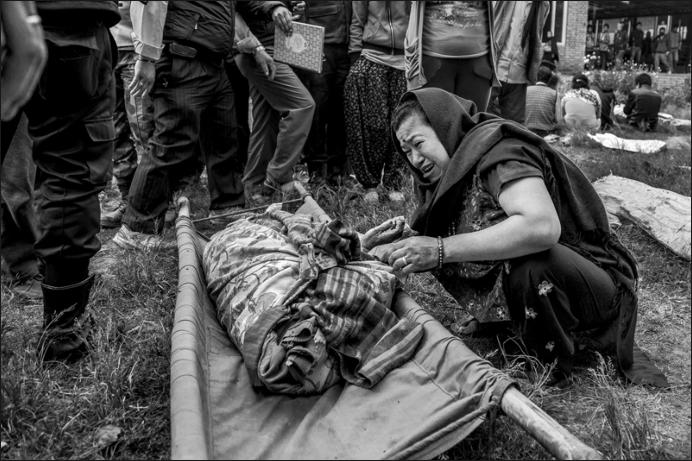
A relative of one of the victims of the earthquake that hit Nepal cries while identifying the body of her mother on April
26, 2015 in Bhaktapur, Nepal. During the days after the earthquake, relatives spent hours searching for survivors in
hospitals and local clinics. Communications were cut for many days making it almost impossible to check on the fate of
relatives across Nepal. Photo by Omar Havana / Getty Images.
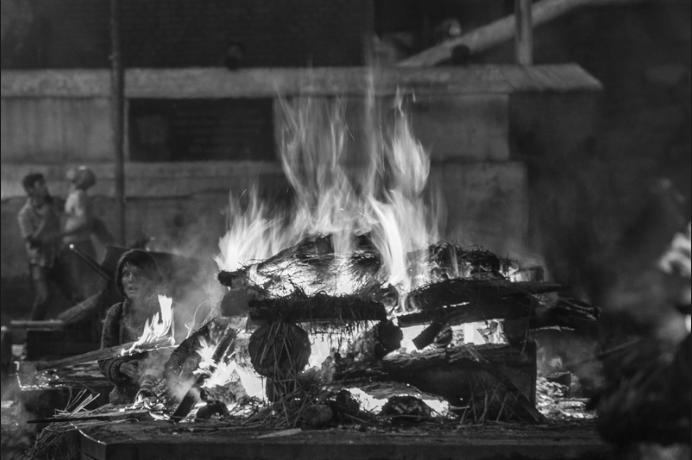
Family members mourn a dead relative during the cremation ritual perfomed in the Pashupatinah temple on April 30,
2015 in Kathmandu, Nepal. Funeral rituals started the day after the earthquake hit Nepal, as hundreds of victims were
cremated in massive ceremonies held by relatives in the cremation sites across the country.
Photo by Omar Havana / Getty Images.
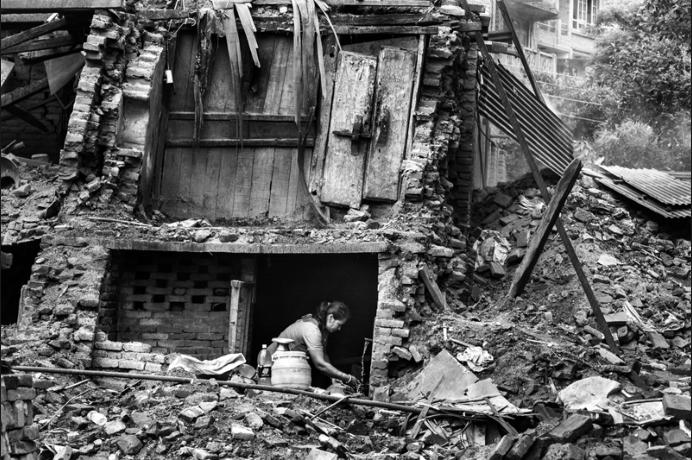
A woman fetches water from a tap inside a partially collapsed house in the city centre of Bhaktapur, Nepal on June 22,
2015. Water sources were heavily damaged after the earthquake and residents risk their lives to fetch water in those
buildings where water is still available. Photo by Omar Havana.
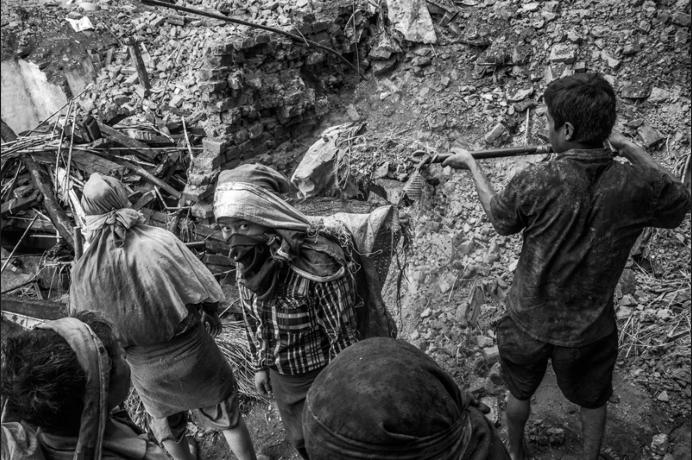
Residents clear debris from their collapsed homes on June 22, 2015 in Harisiddhi, Nepal. Photo by Omar Havana.
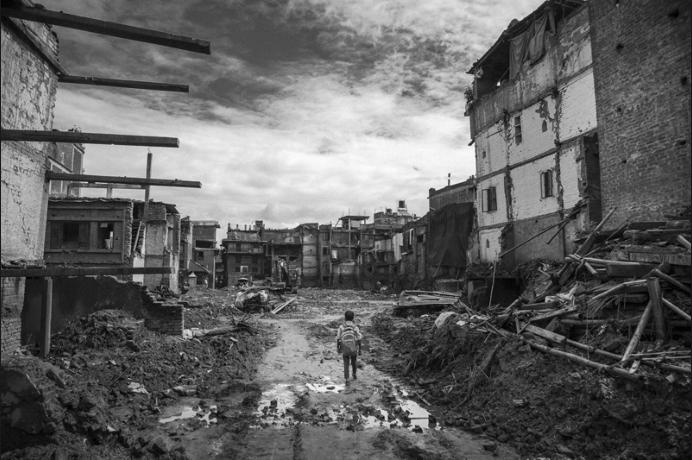
A young boy crosses a square where all the houses collapsed or were destroyed by the earthquake that hit the country
on his way to his school in Bhaktapur, Nepal on July 20, 2015. Months after the earthquake, rebuilding is still far from
starting. Bhaktapur is one of the historic cities situated in the Kathmandu Valley. The city was heavily affected by the
earthquake and hundreds of families lost everything, but life is returning to normality. According to UNICEF, more than
25,000 classrooms in more than 8,000 schools were damaged or destroyed during the earthquake, and thousands of
children are still attending schools in temporary learning centres. Photo by Omar Havana.
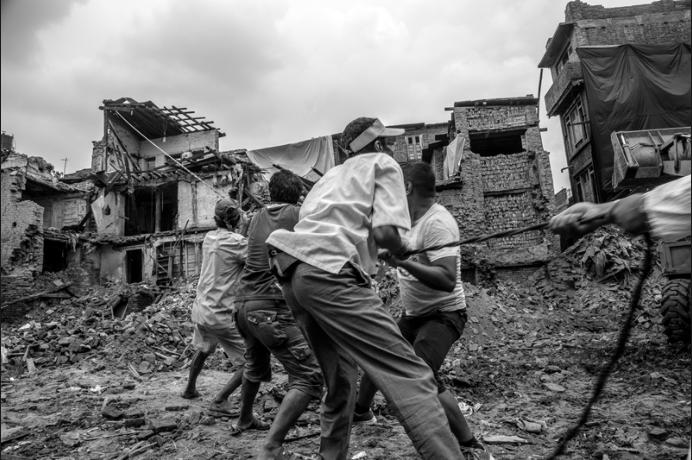
A group of men pull on a rope attached to the roof of a damaged home in order to demolish it in a square where all the
houses were destroyed or damaged during the earthquake that hit Nepal in Bhaktapur, Nepal on July 04, 2015.
Neighbours around the country work together to clean the debris and to bring down houses that were damaged during
the earthquake. Putting their lives at risk, the population of the areas affected by the earthquake have taken the
initiative to start the reconstruction after the passivity of the Government of Nepal. Using basic tools, they clear debris,
and save those materials that they can reuse to build their new homes. According to United Nations, more than half a
million houses were destroyed or damaged during the earthquake that hit Nepal on April 25th. Photo by Omar Havana.
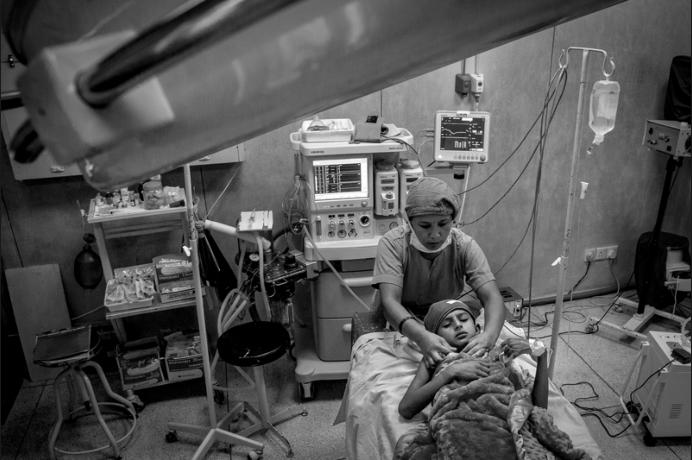
A nurse prepares a young boy for surgery for his injuries obtained during the earthquake in a local hospital on July 07,
2015 in Banepa, Nepal. According to Handicap International, more than 65% of the people injured during the
earthquake suffered fractures and 12% suffered injuries of the spinal cord. With statistics from before the earthquake
indicating that somewhere between 7 and 10% of the population in Nepal was living with a disability of some form, it is
likely that the injuries caused by the earthquake will increase that percentage significantly, leaving an even higher
proportion of the population in need of assistance, yet unable to fully access many services. Photo by Omar Havana.
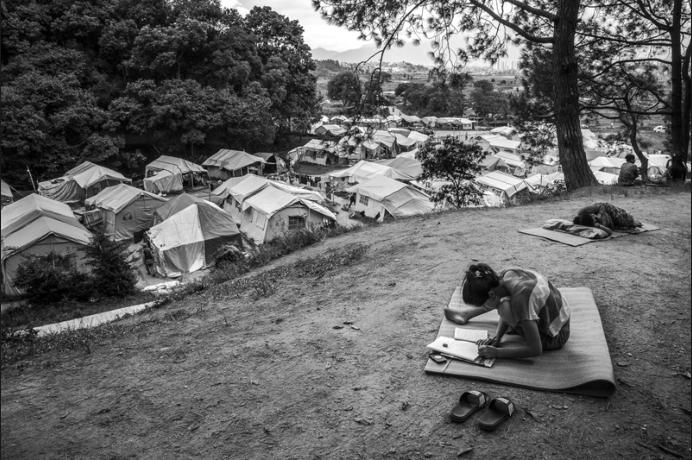
A displaced girl studies on a hill in front of the Bode displacement camp on August 13, 2015 in Bhaktapur, Nepal. There
are 1,087 people living in the displacement camp in Bode, Bhaktapur, all of whom have lost their homes in
Sindupalchowk district, one of the worst affected areas by the earthquake that hit Nepal, and are currently being
supported by NGOs. Approximately 60,000 people are still living in over 100 official displacement camps throughout the
affected districts. Living conditions in the camps are dire, with limited or non-existent access to sanitation services,
clean water and food, and health services. These conditions have been made worse by heavy monsoon rains, as the
camps most often lack drainage systems and are prone to flooding. Photo by Omar Havana / Getty Images.
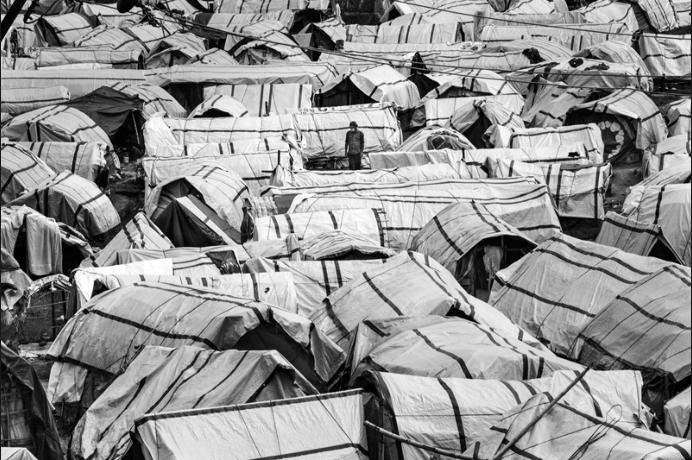
A man walks between hundreds of tents set up in a temporary camp for displaced people on the outskirts of
Kathmandu, Nepal on September 24, 2015. Months after Nepal was hit by the earthquake, hundreds of thousand of
people were still living in temporary shelters waiting for their homes to be rebuilt. The Government of Nepal did not
release the funds donated to help those who lost everything. In the Chhuchepati displacement camp, more than 7,000
people live under temporary roofs according to the Chhuchepati Committee, with several organisations providing help
in this camp. Photo by Omar Havana.
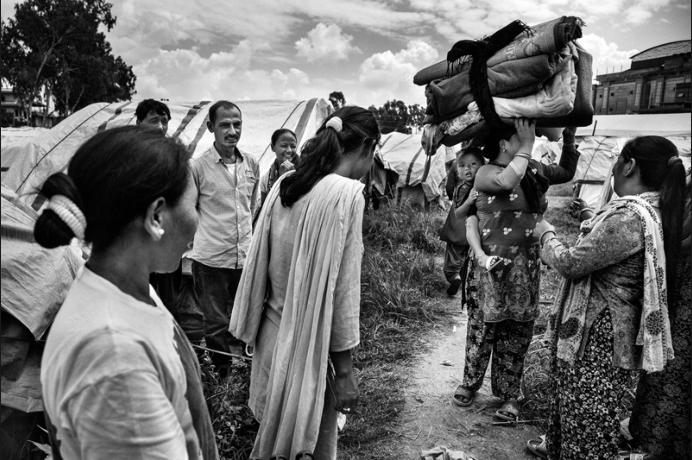
45-year-old Natra Prasath carries belongings out of her tent set up in a temporary camp on the outskirts of Kathmandu
while friends come to say goodbye in Kathmandu, Nepal on September 24, 2015. Displaced people living in temporary
camps are starting to return their villages after the monsoon rain finished. After more than five months living in the
camp, people such as Natra decided to return in order to rebuild their houses while waiting for the Government of
Nepal to release the funds donated to reconstruction. Photo by Omar Havana.
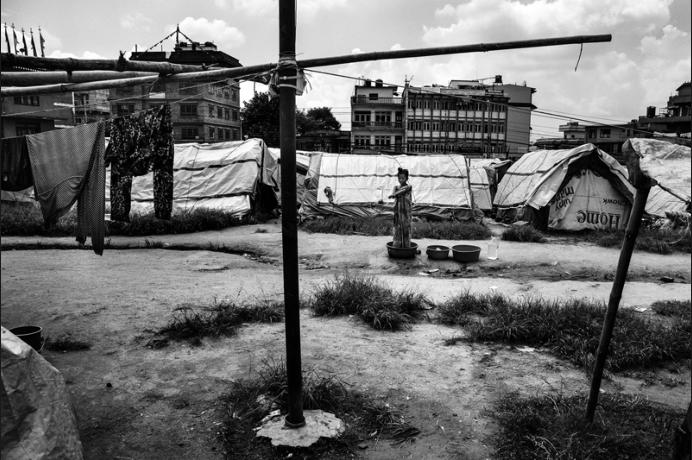
A young girl washes herself using plastic buckets of water in the Chhuchepati temporary camp set up on the outskirts
of Kathmandu, Nepal on September 24, 2015. More than 7,000 people live in the Chhuchepati displacement camp on
the outskirts of Kathmandu months after the earthquake that hit Nepal. Organisations are providing water in this camp.
Water sources were heavily affected by the earthquake. Despite Nepal's extensive natural resources, access to clean
and affordable water remains a problem throughout the country. Although the country made significant progress in
increasing access to water over the past decades, achieving an 84% coverage rate in early 2015, only 25% of the
country’s water supply schemes were considered "well-functioning" ( Department of Water Supply and Sewerage of
Nepal) – statistics which have only worsened in the aftermath of the earthquake that hit the country in April 2015 and
which destroyed and displaced thousands of water sources. Photo by Omar Havana.
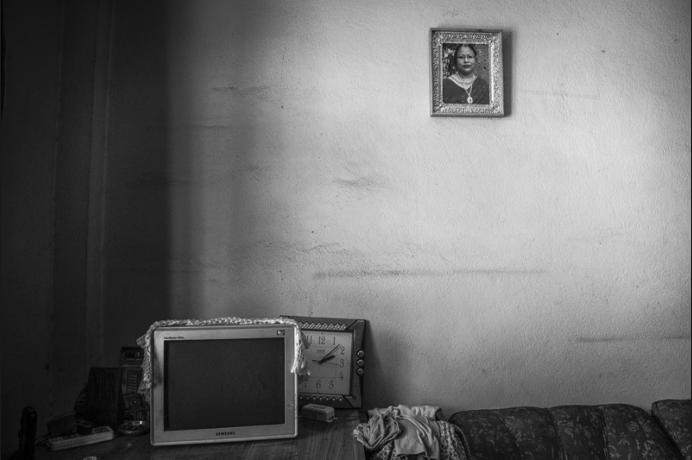
Parbati Prajapati was in her home when the earthquake hit Nepal; she hugged her son while the walls of their homes
collapsed on top of them. Several hours later, they found her son, Pawn, alive covered by debris, while Parbati was
dead still hugging her son. She gave her life protecting her son. Today a picture hangs on the walls of the family home
where Pawn is recovering from injuries to both legs on July 20, 2015 in Bhaktapur, Nepal. Photo by Omar Havana.







